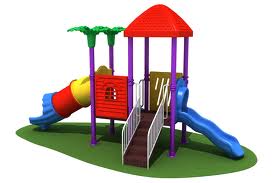*This is a guest post*
Building a playground in your own backyard can give your children lifelong memories, cultivate their imaginations, and instill healthy habits of play and fitness. Read on for some key tips on how to design the ultimate kid’s playground.
Consult the Kids
Once you’ve decided to build a playground on your property, do some initial research to determine what elements you can include given your budget and space constraints. Once you have a few options to choose from, start talking with your children about what they’d like to see in their playground. There’s no point in spending time and money building a playground that your kids won’t enjoy, so involve them in the planning and designing process. Playgrounds can be great spaces for kids to forge friendships and creatively collaborate, so encourage them to think about what types of playground equipment would be most fun to play on with friends and neighbors. Once your children are excited about the playground, it’s time to start planning with their fun, and safety, in mind.
Creative Spaces
As you begin to design your playground, think beyond the typical swing and slide set-up. Playgrounds can be a great place for children to explore and imagine, so try to incorporate some elements that allow for that. A sandbox is great start, but you can take it further by providing buried treasures and fun tools for the kids, like shovels and archaeologists brushes for them to indulge their paleontologist dreams. Other fun additions include tunnels or talk tubes, so kids can play hide and seek and send secret messages across the playground.
Durability
More practically, it’s important to build your playground out of durable materials. Wood may seem like your best bet, but be sure that it is properly treated to withstand the elements to avoid termite infestation or water damage. Wood can be cost-effective, especially when it comes to repairs since typically you can swap out the damaged boards without having to replace a whole section of the structure. Steel is quite durable, but can be too hot or slippery in very hot or wet weather. Generally speaking, synthetic materials are more expensive, but typically last a long time and are resistant to rust and water damage.
Safety
Of course the most important consideration when designing a playground is safety. Consider the areas where kids may be most prone to fall, and reinforce them accordingly. Most slides come equipped with safety bars or fencing at the top, and you can also install springy surfaces made from recycled rubber in order to cushion stumbles and tumbles. The greatest injury prevention comes from adequate adult supervision on the playground, so be sure to give plenty of space for you to watch out for smaller kids on the equipment.
Building a playground is a great way for kids to get exercise, be creative, and enjoy the outdoors. No matter what equipment you choose, your kids are sure to have a blast, and they might even let you take a turn on the monkey bars.
Written by Lachlan Gadd
Lachlan is a proud dad of three boys and runs a construction business in Queensland, Australia. He regularly uses MetroSteel for his steel supplies. When Lachlan isn’t working he spends lots of time in his home workshop doing DIY kids furniture.
Leave a Reply